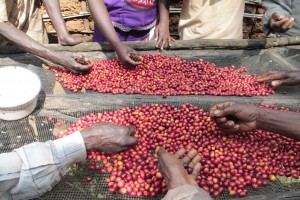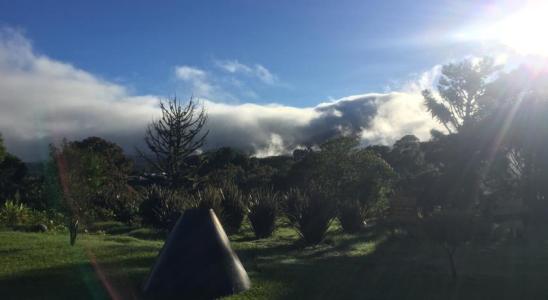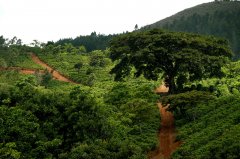El Salvador-Kazakachapa Cooperative introduces manual selection of SHB coffee bean roasting advice
For professional baristas, please follow the coffee workshop (Wechat official account cafe_style)

El Salvador-Kazakachapa (Cuzcachapa) Cooperative Alpine Bean (SHG)
In the coffee of Central and South America, the coffee produced by El Salvador has attracted the attention of the world in recent years, which is the result of close cooperation between small coffee farmers and international coffee organizations that help improve farming and handling methods. The main hope is to increase farmers' income and improve their lives, so that coffee farmers have incentives to change the way of planting to restore the original natural ecology of nature, and the quality of coffee will gradually improve. Make consumers willing to accept coffee produced in El Salvador to combine consumption patterns with natural ecology, which is the most perfect agricultural production and marketing behavior.
Most of the coffee from El Salvador is a traditional bourbon tree species derived from yellow bourbon, orange bourbon, cherry bourbon and sun beans, etc. In the coffee market where every coffee farm must have a unique character, Salvadoran coffee has always been loved by people for its thick fragrance, sweet brown sugar honey and stable and gentle taste.
The Cuzcachapa cooperative in El Salvador was originally established in 1966 by 28 members. At present, more than 1300 small coffee farms across El Salvador have joined the organization of the Cuzcachapa cooperative. The alpine beans produced are the traditional bourbon tree species in El Salvador, which are treated by water treatment. Coffee grows in an organic primeval forest of 3600 feet above sea level and is a high-altitude hard bean (SHG). The Cuzcachapa cooperative has established a good reputation for producing high-quality coffee in El Salvador through excellent planting techniques and centralized treatment of all its members, and occupies a place in the international market with the cooperative's unified sales model. Further improve the lives of coffee farmers to achieve the goal of restoring the original natural ecology of nature.

The proportion of defective alpine beans selected carefully by hand in the cooperative of Cuzcachapa in El Salvador is about 4%, the weight loss ratio of roasted to shallow roasted (city) coffee beans is 14%, and the proportion of empty shell beans to bad beans is 6%. Due to the factor of high mountain beans, shallow roasting can be used to heat up more quickly into an explosion, retaining a little more berry aroma and fruit acid. But it is recommended to use a slower heating method when re-baking, because this is a traditional Salvadoran bourbon tree coffee, hoping to get the most mellow chocolate flavor.
Shallow roasted City (fragrance): the nutty aroma of peanuts is emitted after grinding the beans, and the yellow orange acid turns into drupe sweetness at once. The soft, soft, clean aroma does not taste like the turbid taste of traditional Salvadoran coffee. The sweet finish of green apples is the best performance associated with Costa Rican coffee.
Re-baked (general C) palate: the aroma of hazelnut chocolate is rich, the sweetness of maltose is very pleasant, and the sweet aroma slides over your throat as you breathe, round and balanced with the taste of chocolate caramel. After the whole coffee temperature dropped slightly, the aroma of chocolate slowly moved away from the finish with a hint of orange fruit.
Important Notice :
前街咖啡 FrontStreet Coffee has moved to new addredd:
FrontStreet Coffee Address: 315,Donghua East Road,GuangZhou
Tel:020 38364473
- Prev

Starbucks Zhenxuan Coffee-Starbucks Costa Rican Coffee Story and Flavor introduction
For the exchange of professional baristas, please follow the coffee workshop (Wechat official account cafe_style). The West Valley region of Costa Rica is famous for its bright and refreshing acidity and full body. In order to continuously provide full-bodied, refreshing and sour coffee, the yellow honey treatment is used in this small batch. The use of yellow honey to treat such a difficult technique is to increase coffee.
- Next

How to drink Guatemalan Coffee an introduction to Labassa Manor in the Vivian Plateau
For the exchange of professional baristas, please follow the Coffee Workshop (Wechat official account cafe_style) A brief introduction to the Guatemala Heuheu Finca La Bolsa of Rabessa Manor in the Viv Plateau of Central America in 2017. Rabessa Manor was purchased by Dr. Jorge Vides Molina in 1956 and the estate is owned by
Related
- Detailed explanation of Jadeite planting Land in Panamanian Jadeite Manor introduction to the grading system of Jadeite competitive bidding, Red bid, Green bid and Rose Summer
- Story of Coffee planting in Brenka region of Costa Rica Stonehenge Manor anaerobic heavy honey treatment of flavor mouth
- What's on the barrel of Blue Mountain Coffee beans?
- Can American coffee also pull flowers? How to use hot American style to pull out a good-looking pattern?
- Can you make a cold extract with coffee beans? What is the right proportion for cold-extracted coffee formula?
- Indonesian PWN Gold Mandrine Coffee Origin Features Flavor How to Chong? Mandolin coffee is American.
- A brief introduction to the flavor characteristics of Brazilian yellow bourbon coffee beans
- What is the effect of different water quality on the flavor of cold-extracted coffee? What kind of water is best for brewing coffee?
- Why do you think of Rose Summer whenever you mention Panamanian coffee?
- Introduction to the characteristics of authentic blue mountain coffee bean producing areas? What is the CIB Coffee Authority in Jamaica?

